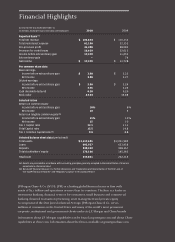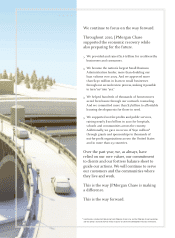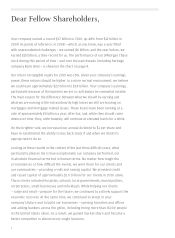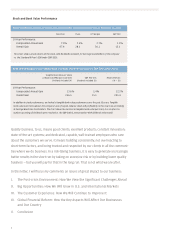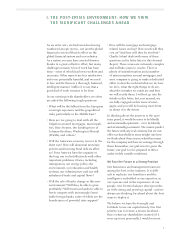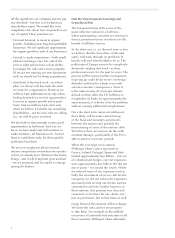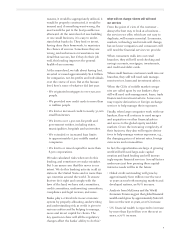JP Morgan Chase 2010 Annual Report Download - page 11
Download and view the complete annual report
Please find page 11 of the 2010 JP Morgan Chase annual report below. You can navigate through the pages in the report by either clicking on the pages listed below, or by using the keyword search tool below to find specific information within the annual report.
9
reasons, it would be appropriately utilized, it
would be properly constructed, it would be
insured and, if something went wrong, the
asset would be put to the best possible use
afterward. At the microlevel of one building
or one small business, it is easy to under-
stand what banks do. They lend or invest,
having done their homework, to maximize
the chance of success. Sometimes they are
wrong, and unforeseen circumstances can
derail that success, but if they do their job
well, this lending improves the general
health of an economy.
At the macrolevel, we talk about having lent,
invested or raised approximately $1.6 trillion
for companies, not-for-profits and individuals
over the course of 2010. But at the human
level, here’s some of what we did last year:
• Weoriginatedmortgagestoover720,000
people.
• Weprovidednewcreditcardstomorethan
11 million people.
• Welentorincreasedcredittonearly30,000
small businesses.
• Welenttoover1,500not-for-protand
government entities, including states,
municipalities, hospitals and universities.
• Weextendedorincreasedloanlimits
to approximately 6,500 middle market
companies.
• Welenttoorraisedcapitalformorethan
8,500 corporations.
Wetakecalculatedriskswhenwedothis
lending, and sometimes we make mistakes.
But I can assure you that this never is our
intent.Wedothisbankingactivityinall50
statesintheUnitedStatesandinmorethan
140 countries around the world. To ensure
that we do it right and comply with the
laws of the land, we have risk committees,
credit committees, underwriting committees,
compliance and legal reviews, and more.
Banks play a critical role in our economic
system by properly allocating, underwriting
and understanding risk as credit is given to
various entities and by helping to manage,
move and invest capital for clients. The
key question is how will all the regulatory
changesaectthebanks’abilitytodothis?
What will not change: Clients still will need
our services
From the point of view of the customer –
always the best way to look at a business –
the services we oer, which are not easy to
duplicate,willremainessential.Economies,
markets, technology and trends will change,
but we know companies and consumers still
will need the financial services we provide.
Whenconsumerswalkintoourretail
branches, they still will need checking and
savings accounts, mortgages, investments,
and credit and debit cards.
Whensmallbusinesscustomerswalkintoour
branches, they still will need cash manage-
ment services, loans and investment advice.
WhentheCEOsofmiddlemarketcompa-
nies are called upon by our bankers, they
still will need cash management, loans, trade
finance and investment advice. Some even
may require derivatives or foreign exchange
services to help manage their exposures.
Finally, when large companies work with our
bankers, they will continue to need merger
and acquisition or other financial advice
and access to the global equity and debt
markets. Given the increasing complexity of
their business, they also will require deriva-
tives to help manage various exposures, e.g.,
the changing prices of interest rates, foreign
currencies and commodities.
In fact, the opportunities are large. A growing
world still will need large-scale capital
creation and bank lending and will increas-
ingly require financial services. Several factors
underscore just how pressing these capital-
intensive needs will be in the future:
• Globalcreditoutstandingwillgrowby
approximately $100 trillion over the next
10 years across both emerging markets and
developed nations, an 80% increase.
• AnalystsfromMcKinseyandtheWorld
EconomicForumsuggestthatglobalnancial
wealth could grow by approximately $160 tril-
lion over the next 10 years, a 100% increase.
• U.S.nancialwealthisexpectedtoincrease
by more than $30 trillion over the next 10
years,a70%increase.


